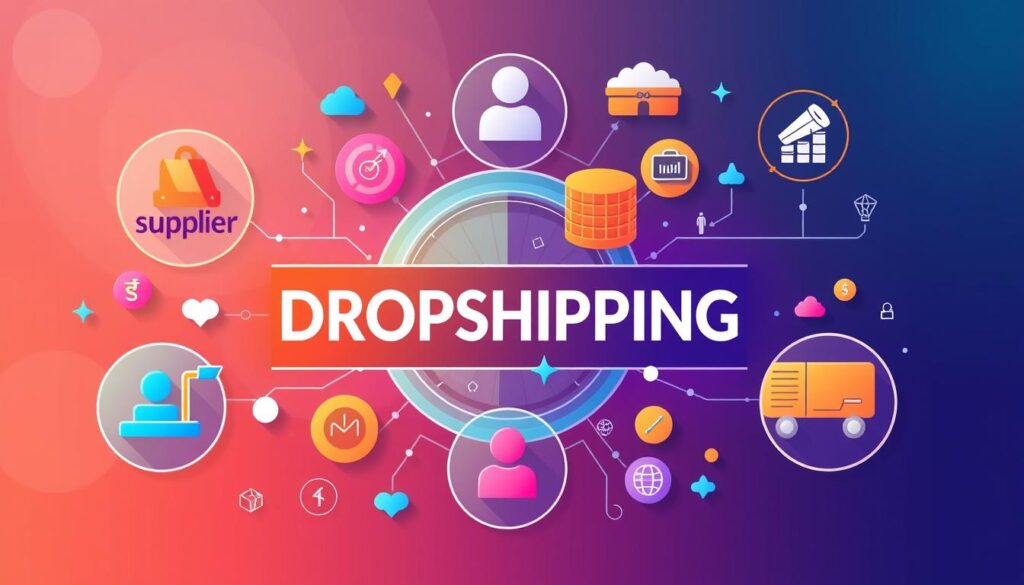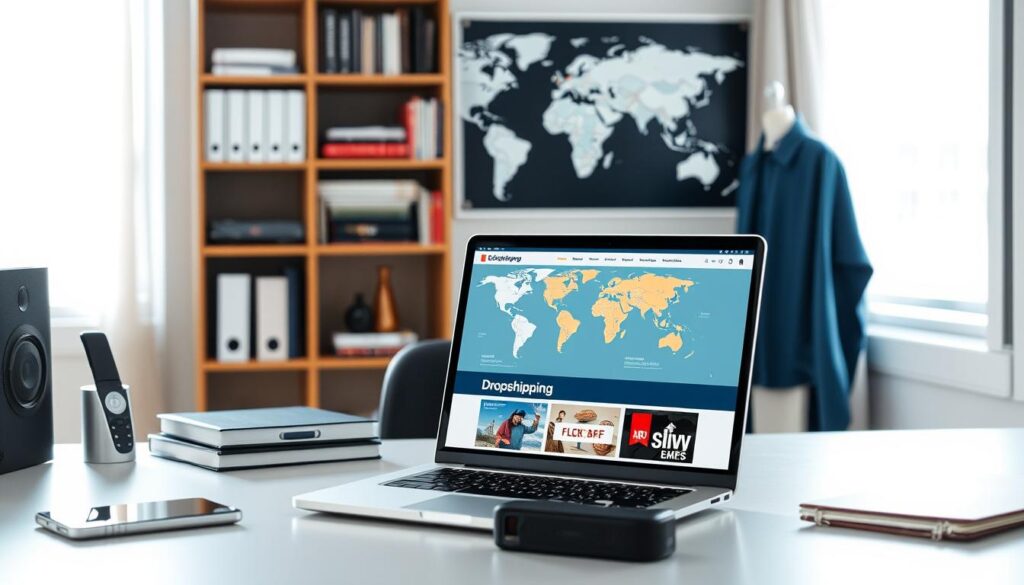Imagine you’re at home, browsing your favourite online store. You find a unique pair of sunglasses that match your style. You add them to your basket. But, you might not know the retailer doesn’t keep any stock; they use dropshipping!
This new way of selling is changing online shopping. It lets new business owners start without worrying about stock. In this dropshipping guide, we’ll show you how it works. We’ll talk about its benefits and what it takes to succeed. Get ready to learn all about this exciting business model!
Table of Contents
Key Takeaways
- Dropshipping generates over $300 billion in annual e-commerce sales.
- It allows retailers to offer a variety of products without managing inventory.
- Initial investment costs are significantly lower than traditional retail models.
- Businesses can be operated from any location with internet access.
- Testing customer interest in new product categories is simplified through dropshipping.
- Scalability is a major advantage, thanks to platforms like Amazon and eBay.
- Quality control and shipment speed are key to success in dropshipping.
What is Dropshipping?
Dropshipping is a way to sell products online without keeping any stock. It’s great for beginners because it means you don’t need to worry about storing products. When someone buys something, you just send the order to a supplier who ships it out.
This makes it easier to start a business because you don’t need a lot of money for stock or a big warehouse. It helps businesses save money and grow.
Understanding the Dropshipping Model
The dropshipping model has many benefits over traditional retail. You can start a business with little money, which is good for trying out different products and markets. It also means you don’t have to worry about unsold items.
Almost 84% of people think delivery is key when shopping online. This shows how important it is to get orders to customers quickly and efficiently. Dropshipping lets you run a business from anywhere, which is perfect for those who love to travel or work from different places.
Roles in a Dropshipping Business
In a dropshipping business, there are a few important roles:
- Retailer: This is the person who sells the products and talks to customers.
- Dropshipping Supplier: They keep the products and send them to customers.
- Customer: The person who buys the products and gets them delivered.
This setup is flexible, which means you can change what you sell and respond to market changes easily. It’s also appealing to new business owners because it doesn’t cost a lot to start.
| Role | Responsibilities |
|---|---|
| Retailer | Markets products, manages customer service, and collects payments. |
| Dropshipping Supplier | Stores inventory, ships products, and manages stock levels. |
| Customer | Makes purchases, provides feedback, and influences market trends. |
How Dropshipping Works
Dropshipping is a great way to start an online store with little effort. It’s a simple model that lets you sell products without holding any stock. We’ll show you how it works and give tips to help you get started.
Step-by-Step Dropshipping Process
The dropshipping journey starts with finding a supplier. You list their products online without buying stock first. Here’s what you need to do:
- Select a Niche: Look for products that are in demand and profitable. Check out the competition and see if there’s a need for what you want to sell.
- Find Reliable Suppliers: Find suppliers that offer good products and are reliable. Make sure they meet your quality standards.
- Set Up Your Online Store: Pick a platform like Shopify or BigCommerce. It will help you set up product pages and handle payments.
- Market Your Products: Use marketing to get people to visit your store. Try to turn visitors into customers.
- Manage Customer Orders: When someone orders, send the details to your supplier. They’ll pack and ship the product to the customer.
- Provide Customer Service: Help with any customer questions or problems. This keeps customers happy and builds trust.
The Importance of Supplier Relationships
Good relationships with suppliers are key to success in dropshipping. They affect how fast and well products are delivered. Here’s why these relationships are so important:
| Aspect | Importance |
|---|---|
| Timeliness | Ensures orders are delivered on time, making customers happy. |
| Quality Control | Keeps product standards high, reducing returns and complaints. |
| Flexibility | Allows for quick changes to meet demand changes. |
| Cost-Effectiveness | Can lead to better prices and higher profits. |
Building strong supplier relationships is vital for new dropshipping businesses. It helps manage the challenges of dropshipping and sets the stage for growth. For more on starting a dropshipping business, check out this resource.
Dropshipping Explained: Key Terminology
It’s vital to know the key terms in dropshipping to do well in ecommerce. There are different roles in a dropshipping business. Each role has its own job to help the business run smoothly and succeed.
Defining Key Roles in Dropshipping
The main roles in dropshipping are:
- Retailer: This person sells products to customers. They are the last part of the supply chain.
- Supplier: This is the company that provides the products. They are chosen for their good prices to help the retailer make more money.
- Customer: The person who buys products from the retailer.
In dropshipping, sellers don’t keep any stock. They rely on wholesalers to handle shipping and packaging. This model is great because it doesn’t need a lot of money upfront. It lets sellers offer many products without having to keep any stock.
Understanding Order Fulfilment
Order fulfilment is the whole process from when a customer orders something to when they get it. It includes:
| Stage | Description |
|---|---|
| Order Processing | Checking the order details and starting the fulfilment process. |
| Inventory Management | Keeping track of what products are available and when to order more. |
| Shipping | Managing the logistics of getting the products from suppliers to customers. |
| Returns Handling | Dealing with product returns and refunds to keep customers happy. |
This structured way helps dropshipping businesses run well and save money. Knowing how order fulfilment works is key to a successful dropshipping strategy.
The Advantages of Dropshipping
Dropshipping is a great way to start an online business, even if you’re new. It’s easy to begin with little money. Let’s look at some of the main benefits.
Low Initial Investment Costs
Dropshipping is cheap to start, which is a big plus. You don’t need to buy lots of stock first. This means you can start your business without a big risk.
Flexibility and Mobility in Business Operations
Dropshipping lets you work from anywhere with internet. It’s perfect for those who want to balance work and life. You can quickly change your business to keep up with trends.
Wide Range of Products Without Inventory Commitment
Dropshipping means you can sell lots of products without storing them. This lets you try new things without big risks. You can also respond quickly to what customers want. For more on dropshipping benefits, check this link.
The Disadvantages of Dropshipping
Dropshipping has its good points, but there are also downsides to consider. These can impact a business’s success over time.
Low Profit Margins
One big problem is the low profit margins. Dropshippers usually make about 20% profit. This is because of higher costs from suppliers.
With a 2% conversion rate, making a profit can be tough. The profit formula is: (Traffic x 0.02) x (Avg order value x 0.2) = Profit. Low traffic makes it hard to make a living.
High Competition and Market Saturation
The dropshipping world is very competitive. Many start-ups find it hard to stand out. This is because it’s easy to start a business, leading to too many in the market.
To get noticed, you need creative marketing. This includes SEO and social media ads. Without a unique selling point, making money is hard.
Limited Control Over Supply Chain
Dropshippers have little control over their supply chain. This means they can’t always ensure product quality or delivery times. It also makes meeting legal sales rules harder.
For more on dropshipping, check out our detailed guide here. Overcoming these challenges needs careful planning and strategy to succeed in a tough market.
Dropshipping Business Model: Is It Right for You?
Exploring the dropshipping business model for entrepreneurs is key. It’s important to know your strengths and what the market needs. Skills in marketing or customer service can boost your success. Checking these skills and market demand is a must.
Identifying Your Strengths and Skills
Before starting a dropshipping business, it’s important to know your abilities. Ask yourself these questions:
- What experience do I have in online marketing or eCommerce?
- How good am I at handling customer service?
- Can I manage logistics and talk to suppliers well?
Answering these questions will show if you’re ready to start. Using your strengths is a top tip for growing your business.
Assessing Market Demand
Knowing the market demand is critical for your dropshipping journey. Here are some steps to take:
- Do thorough market research to find trending products.
- Use online tools to check competitors and their products.
- Look at customer reviews and feedback on products you’re interested in.
Dropshipping has grown to a global market worth over USD 284 billion in 2023. Knowing what customers want is key. The market is expected to reach USD 1,253.79 billion by 2030. Finding a niche that interests you and meets demand is essential for success.
| Aspect | Importance |
|---|---|
| Identifying Strengths | Helps manage business demands |
| Market Demand | Directly affects product success and profit |
| Customer Service Skills | Keeps customers happy and loyal |
| Marketing Knowledge | Crucial for attracting customers and sales |
By carefully looking at your skills and market demand, you’re set for a successful dropshipping journey. Success in this model needs careful planning and dedication. But with the right approach, the future is bright.
Essential Dropshipping Tips for Beginners
Starting in dropshipping is both thrilling and tough. With the right strategies, beginners can lay a solid base for their business. Here are key dropshipping tips to help you build a successful venture.
Choosing Your Niche Wisely
Picking the right niche is vital for dropshipping beginners. Choose areas that interest you, so you can genuinely promote your products. Use tools like Google Trends to check market trends. Look at competition and make sure there’s enough demand to meet your sales goals.
Remember, a crowded market needs creative ways to stand out.
Effective Marketing Strategies
Good marketing is key to dropshipping success. Use SEO, social media, and email marketing. Platforms like Instagram and Facebook can bring lots of visitors to your store. Working with influencers can also help you reach more people.
Keep tweaking your marketing based on what your analytics say to get better results.
Building Trust with Customers
Trust is essential for a thriving dropshipping business. Offer top-notch customer service and clear communication. Make sure your website looks professional and easy to use. Customer reviews and trust badges can make you seem more credible.
Quickly answering customer questions and having easy return policies can keep customers coming back and loyal to your brand.
| Tip | Description |
|---|---|
| Choose Your Niche | Identify a market that excites you while ensuring demand and manageable competition. |
| Marketing Strategies | Employ multiple channels and adjust approaches based on performance analytics. |
| Build Trust | Focus on outstanding service and a professional website to enhance customer confidence. |
Exploring Dropshipping Platforms
Starting a dropshipping business means picking the right platforms. The right platforms are key to making your business run smoothly. Let’s look at some top choices and what they offer.
Popular Dropshipping Options
- Shopify: Shopify is easy to use and offers lots of e-commerce tools. It starts at £29 a month. You get unlimited products, payment options, and mobile-friendly sites.
- WooCommerce: WooCommerce is perfect for WordPress users. It’s free but you might need to pay for extra features. It lets you tailor your online store exactly how you want.
- BigCommerce: BigCommerce is for all business sizes. It costs £29.95 a month. You get tools for selling on multiple channels and SEO help.
- eBay: eBay is huge, with nearly 900 million visitors every month. It’s easy to use for dropshipping. You pay a 5% fee or £0.40 per sale.
- Facebook Marketplace: Facebook Marketplace is easy to use. It’s free, with a 5% fee or £0.40 per sale. It’s great for reaching local buyers.
Comparing Features and Pricing
| Platform | Starting Price (Monthly) | Key Features |
|---|---|---|
| Shopify | £29 | User-friendly, Unlimited products, Mobile optimisation |
| WooCommerce | Free (Additional costs for add-ons) | Highly customisable, WordPress integration |
| BigCommerce | £29.95 | Multi-channel selling, Advanced SEO tools |
| eBay | Transaction-based | Large audience, Simple listing |
| Facebook Marketplace | Transaction-based | Local selling, Vast user base |
Managing Customer Service in Dropshipping
Good customer service is key for a dropshipping business to thrive. Customers like quick responses and well-dealt inquiries. This can make them loyal and boost your reputation. By using smart customer service strategies, we can make buying experiences better, leading to more repeat customers.
Handling Customer Inquiries and Complaints
Dealing with customer questions well needs a few steps. Studies show 75% of customers want the same service everywhere, like on social media, email, and live chat. Here are some tips to meet these needs:
- Offer different ways to talk, like email, phone, and live chat.
- Use automated CRM tools for personal replies based on customer info.
- Have a ticket system to keep track of customer questions.
- Always contact customers after they buy to check if they’re happy and fix any issues.
- Ask for feedback and reviews to keep improving your service.
Building an Efficient Returns Process
A smooth returns process is vital for good customer service. A clear returns policy makes customers happy and cuts down complaints. Here’s how to make your returns process better:
- Make your return policy clear on your website, so it’s easy to find and understand.
- Think about a self-service portal to make returns easier for customers.
- Use feedback to find out why customers return things, so you can improve.
- Have a clear plan for keeping customers updated during the return process.
- Give rewards, like discounts or loyalty points, to keep customers coming back even after returns.
Great customer service in dropshipping can really help keep customers and get more referrals. Stats show 86% of customers are willing to pay more for better service. By focusing on good customer service, we can build a strong and lasting dropshipping business.
Maximising Your Dropshipping Profit Margin
To succeed in dropshipping, knowing how to boost profit margins is key. Good pricing strategies help you sell well and make money. This part talks about setting prices right and cutting costs to improve your earnings.
Understanding Pricing Strategies
Choosing the right price is vital for your sales and profits. Dropshipping profits can range from 10% to 30%. Aiming for a 20% profit margin is a good start for beginners.
Consider these important factors:
- Cost of Goods Sold (COGS)
- Average Order Value (AOV)
- Conversion Rate
Many shoppers (over 66%) want free shipping. Adding this to your prices can make you more competitive. To work out profit margin, use this formula: [(Income – Expenses) / Income] * 100. This formula includes all costs, like fees and marketing expenses.
Reducing Operational Costs
Lowering costs is key to higher profits in dropshipping. Look at all expenses, like shipping and ads. For example, Facebook ads can cost £5 to £50 daily, and fees for payments average 2.9%.
Use free platforms like Facebook Marketplace to save on fees. Also, improve your shipping and talk better rates with suppliers. Knowing these tips can really help your profits.
Learn more about successful dropshipping by reading detailed guides. They can help you make more money and save costs. A strong plan is essential for success in this fast-changing market. For more tips, see this article on dropshipping business plans.
Conclusion
This dropshipping guide has shown us how it can be a good start for new business owners. It’s a big deal in e-commerce, making over $300 billion a year. It’s great because you don’t need a lot of money to start, and you can work from anywhere.
But, it’s important to know both the good and bad sides. Selling lots of products without storing them sounds good, but finding reliable suppliers and dealing with long shipping times can be tough. You might want to use tools to pick a unique name for your business. This can help make your brand stand out. For more tips, check out this link: naming your dropshipping business effectively.
Starting a dropshipping business needs careful planning and being open to change. By using the tips we’ve given, you can create a plan that fits your goals. Whether you’re new to dropshipping or looking to improve, it can lead to success in the ever-changing world of e-commerce.
FAQ
What is dropshipping?
Dropshipping is a way to sell products without keeping them in stock. You sell items and then send the order to a supplier. They ship the product directly to the customer.
How does dropshipping work?
First, you partner with a supplier and set up an online store. You list products for sale. When someone buys, you send the order to the supplier. They then ship it to the customer.
What are the advantages of dropshipping?
Dropshipping is great because it doesn’t cost much to start. It’s flexible and lets you sell lots of products without keeping inventory. It’s perfect for new e-commerce businesses!
What are the disadvantages of dropshipping?
Dropshipping can be tough because profits are often low. There’s a lot of competition, and you have less control over shipping. These issues can make it hard to make money.
Is the dropshipping business model right for me?
Think about your skills and interests to decide if dropshipping is for you. Good marketing and customer service are key to success in this model.
What tips do you have for beginners in dropshipping?
Start by picking a niche with good market demand. Use SEO and social media to market. Focus on keeping customers happy to grow your business.
What platforms are best for dropshipping?
Shopify, WooCommerce, and BigCommerce are top choices. Each has different features and prices. Pick one that fits your business needs.
How can I manage customer service effectively in dropshipping?
Good customer service means quick replies to questions and complaints. Have a clear returns policy and keep in touch with customers. This builds trust and loyalty.
How can I maximise my dropshipping profit margin?
To increase profits, learn about pricing and cut costs. This will help your business grow and stay profitable.






